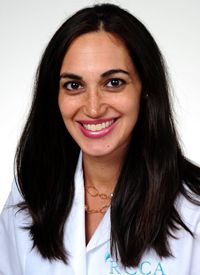Article
Ongoing Advances Transforming Treatment in Myeloma
Author(s):
Noa Biran, MD, discusses treatment breakthroughs and emerging advances in the field of multiple myeloma.
Noa Biran, MD

Noa Biran, MD
Although there is still a gap in physicians’ treatment arsenal for high-risk patients with multiple myeloma, that is not to discount the great strides physicians have made in the landscape, explains Noa Biran, MD.
For example, results from the SWOG S0777 trial confirmed the superiority of triplet regimens to doublets in the newly diagnosed setting, said Biran. The benefit in progression-free survival (PFS) and overall survival (OS) extended to both transplant-eligible and transplant-ineligible patients who were randomized to upfront bortezomib (Velcade), lenalidomide (Revlimid), and dexamethasone versus lenalidomide and dexamethasone alone. The median PFS was 43 months versus 30 months with the bortezomib and lenalidomide/dexamethasone-alone arms, respectively; moreover, median OS was 75 months with the addition of bortezomib versus 64 months with lenalidomide/dexamethasone alone.
“There's a deepening response over time in [many triplet] regimens,” said Biran.
OncLive: How has the treatment for newly diagnosed multiple myeloma evolved?
In an interview during the 2018 OncLive® State of the Science SummitTM on Hematologic Malignancies, Biran, of the Myeloma Division at John Theurer Cancer Center, discussed treatment breakthroughs and emerging advances in the field of multiple myeloma.Biran: There are several different areas including transplant-eligible patients, transplant- ineligible patients, and the role of transplant. In the newly diagnosed setting, triplets are better than doublets in both patient populations. They achieve a very rapid and deep response. That usually translates into a longer duration of remission. The SWOG S0777 trial randomized patients who did not go onto transplant to either upfront bortezomib, lenalidomide, and dexamethasone, or lenalidomide and dexamethasone alone. The patients who received the triplet had a much longer PFS and OS. It’s important to keep transplant-ineligible patients on a triplet regimen.
Daratumumab (Darzalex) plus bortezomib, melphalan, and prednisone (VMP) is up for FDA approval. How will this therapy impact the landscape?
Will newly diagnosed patients benefit from the January 2018 FDA approval of denosumab (Xgeva)?
In the transplant setting, the EMN02/HO95 study looked at a single versus double transplant and showed an improvement in PFS [with double transplant]. This extended to patients who received tandem transplant and was seen especially in high-risk patients.In the United States, melphalan is not used very commonly in the upfront setting, even in transplant-ineligible patients. I'm not sure if that particular regimen will change the treatment landscape. However, it may translate into the use of upfront daratumumab in a triplet regimen in transplant-ineligible patients. There are several studies that are evaluating that. The MAIA study is looking at daratumumab, lenalidomide, and dexamethasone in transplant-ineligible patients. Those results are more likely to change the treatment landscape in the United States. Absolutely. Denosumab was recently approved for patients with bone lesions. The published study was a noninferiority trial comparing denosumab with zoledronic acid in patients with multiple myeloma. Denosumab was noninferior in the primary endpoint of skeletal-related events (SREs). The secondary endpoint also showed a slight PFS advantage.
How can interventions with antibiotics and influenza vaccines supplement therapies?
Denosumab is a RANK-Iigand inhibitor—not a bisphosphonate—so it's not cleared by the kidneys. Around 40% of patients with multiple myeloma have renal insufficiency at diagnosis, so this treatment aids in improving bone strength and decreasing SREs without compromising renal function. It's going to be very important for our patients with renal insufficiency who have lytic lesions, or other bone related lesions at diagnosis. Infections are very common in patients with multiple myeloma. Most people with the disease die from an infection rather than from the disease itself. Everybody who is on a proteasome inhibitor should be on a prophylaxis with acyclovir or valacyclovir and should remain on that for at least 3 months following the last dose of the proteasome inhibitor.
Are there any data with upfront chimeric antigen receptor (CAR) T-cell therapy in myeloma?
What ongoing research or clinical trials are you excited about?
What is the unmet need in multiple myeloma?
In addition, it is recommended for all patients with myeloma to receive the influenza vaccine up to twice in one season if the first one is given early. It's likely beneficial to have a second booster of the flu shot later in the disease course. Although it doesn't provide full protection, it's better than nothing. Not yet. Right now, CAR T-cell trials are all in the relapse setting. When there is further long-term follow up of CAR T-cells in the relapse setting, it will likely be brought into the upfront setting. Trials looking at what to do after high-dose chemotherapy and stem cell transplant are going to be very informative. Also, trials that are looking at changing management based on minimal residual disease negativity will be very informative. We still don’t have good options for high-risk patients. The standard-risk patients are living for decades. However, our high-risk patients, despite all these improvements, are still living a median survival of 2 years. We need to focus on how we're going to help these patients.
Durie B, Hoering A, Abidi M, et. al. Bortezomib with lenalidomide and dexamethasone versus lenalidomide and dexamethasone alone in patients with newly diagnosed myeloma without intent for immediate autologous stem-cell transplant (SWOG S0777): a randomised, open-label, phase 3 trial. The Lancet. 389;519-527. doi: 10.1016/S0140-6736(16)31594-X.









%20(2)%201-Recovered-Recovered-Recovered-Recovered-Recovered.jpg?fit=crop&auto=format)